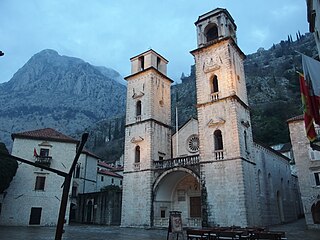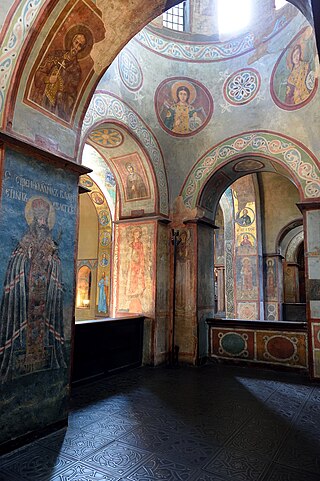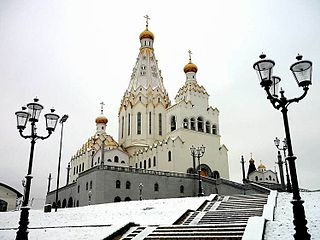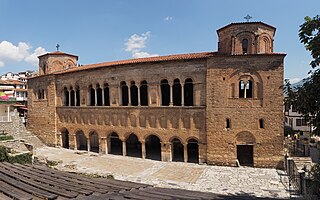Greek Orthodox Church is a Christian term that can refer to any one of three classes of church, each associated in some way with Greek Christianity or the Eastern Roman Empire.
The most common religion in Albania is Islam, with the second-most-common religion being Christianity. There are also a number of irreligious Albanians. There are no official statistics regarding the number of practicing religious people per each religious group.

The dominant religion in Vojvodina is Orthodox Christianity, mainly represented by the Serbian Orthodox Church, while other important religions of the region are Catholic Christianity, Protestant Christianity, Islam, and Judaism.

Religion has been a major influence on the societies, cultures, traditions, philosophies, artistic expressions and laws within present-day Europe. The largest religion in Europe is Christianity. However, irreligion and practical secularisation are also prominent in some countries. In Southeastern Europe, three countries have Muslim majorities, with Christianity being the second-largest religion in those countries. Ancient European religions included veneration for deities such as Zeus. Modern revival movements of these religions include Heathenism, Rodnovery, Romuva, Druidry, Wicca, and others. Smaller religions include Indian religions, Judaism, and some East Asian religions, which are found in their largest groups in Britain, France, and Kalmykia.

Evangelical Protestantism is one of five officially recognized faiths in Albania. It is a Christian faith that views Jesus Christ as its founder and head, and the Bible as its written authority.

Serbia has been traditionally a Christian country since the Christianization of Serbs by Clement of Ohrid and Saint Naum in the 9th century. The dominant confession is Eastern Orthodoxy in the fold of Serbian Orthodox Church.

Eastern Orthodox Christianity is largest religion in Montenegro, but there are also sizeable numbers of adherents of both Catholic Christianity and Islam.

Religion in Bulgaria has been dominated by Christianity since its adoption as the state religion in 864. The dominant form of the religion is Eastern Orthodox Christianity within the fold of the Bulgarian Orthodox Church. During the Ottoman rule of the Balkans, Islam spread to the territories of Bulgaria, and it remains a significant minority today. The Catholic Church has roots in the country since the Middle Ages, and Protestantism arrived in the 19th century; both of them remain very small minorities. Today, a significant part of the Bulgarians are not religious, or believers who do not identify with any specific religion, and Bulgaria has been the cradle of some new religions, notably the Neo-Theosophical movement of Dunovism.

Religion in Austria is predominantly Christianity, adhered to by 68.2% of the country's population according to the 2021 national survey conducted by Statistics Austria. Among Christians, 80.9% were Catholics, 7.2% were Orthodox Christians, 5.6% were Protestants, while the remaining 6.2% were other Christians, belonging to other denominations of the religion or not affiliated to any denomination. In the same census, 8.3% of the Austrians declared that their religion was Islam, 1.2% declared to believe in other non-Christian religions, and 22.4% declared they did not belong to any religion, denomination or religious community.

Christianity is the predominant religion in Ukraine, with 85% of the population identifying as Christian according to a 2022 survey conducted by the Kyiv International Institute of Sociology (KIIS). Seventy-two percent of the population avowed fidelity to an Eastern Orthodox Church: 54% of Ukrainians proclaimed adherence to the autocephalous Orthodox Church of Ukraine; 14% identified as Orthodox Christian without specifying a church affiliation; 4% associated with the Moscow Patriarchate. Another 9% of Ukrainians professed devotion to the Catholic Church in Ukraine: 8% Ukrainian Greek Catholics and 1% Latin Catholics. Two percent of the population declared affiliation to a mainstream Protestant Church, and a further 2% identified with some alternative sect of Christianity.

Christianity has dominated Guatemalan society since its Spanish colonial rule, but the nature of Christian practice in the country has changed in recent decades.

Religion in Greece is dominated by Christianity, in particular the Greek Orthodox Church, which is within the larger communion of the Eastern Orthodox Church. It represented 90% of the total population in 2015 and is constitutionally recognized as the "prevailing religion" of Greece. Religions with smaller numbers of followers include Islam, Roman Catholicism, Greek Catholicism, Judaism, Evangelicalism, Hellenic paganism, and Jehovah's Witnesses. Also a small number of Greek atheists exist, not self-identifying as religious. Religion is key part of identity for most Greeks, with 76% of Greeks in a 2015–2017 survey saying that their nationality is defined by Christianity. According to other sources, 81.4% of Greeks identify as Orthodox Christians and 14.7% are atheists.

The dominant religion in Slovenia is Christianity, primarily the Catholic Church, which is the largest Christian denomination in the country. Other Christian groups having significant followings in the country include Eastern Orthodoxy and Protestantism (Lutheranism). Islam, Judaism and Hinduism are small minorities in Slovenia. About 18% of the population are either agnostic or atheist.

Christianity is the main religion in Belarus, with Eastern Orthodoxy being the largest denomination. The legacy of the state atheism of the Soviet era is evident in the fact that a part of the Belarusians are not religious. Moreover, other non-traditional and new religions have sprung up in the country after the end of the Soviet Union.

Religion in Kosovo is separated from the state. The Constitution establishes Kosovo as a secular state that is neutral in matters of religious beliefs and where everyone is equal before the law and freedom to belief, conscience and religion is guaranteed.

In North Macedonia, the most common religion is Eastern Orthodox Christianity, practiced mainly by ethnic Macedonians, Serbians, Vlakhs, and Romanis. The vast majority of the Eastern Orthodox in the country belong to the Macedonian Orthodox Church, which declared autocephaly from the Serbian Orthodox Church in 1967.

Estonia, historically a Lutheran Christian nation, is today one of the least religious countries in the world in terms of declared attitudes, with only 14 percent of the population declaring religion to be an important part of their daily life. This is thought to largely be a result of the Soviet occupation of Estonia in 1940, prior to which Estonia had a large Christian majority.
Eastern Orthodoxy arrived in the areas of Illyrii proprie dicti or Principality of Arbanon during the period of Byzantine Empire. Those areas fell under the Ottoman Empire during the late medieval times and Eastern Orthodoxy underwent deep sociopolitical difficulties that lasted until the fall of the Ottoman Empire. Between 1913 and until the start of WWII under the newly recognized state of Albania, Eastern Orthodoxy saw a revival and in the 1937 the Autocephaly after a short Eastern Orthodoxy schism and contestation was recognized. Decades of persecution under the Communist state atheism, which started in 1967 and officially ended in December 1990, greatly weakened all religions and their practices especially Christians of Albania. The post-communist period and the lifting of legal and other government restrictions on religion allowed Orthodoxy to revive through institutions and enabled the development of new infrastructure, literature, educational facilities, international transnational links and other social activities.
The Ghegs are one of two major dialectal subgroups of Albanians They are also differentiated by minor cultural, dialectal, social and religious characteristics. The Ghegs live in Albania, Kosovo, North Macedonia, Serbia and Montenegro. The Ghegs speak Gheg Albanian, one of the two main dialects of Albanian language. The social organization of the Ghegs was traditionally tribal, with several distinct tribal groups of Ghegs.
Based on the numbers of adherents, the Eastern Orthodox Church is the second largest Christian communion in the world, after the Roman Catholic Church, with the most common estimates of baptised members being approximately 220 million. The numerous Protestant groups in the world, if taken all together, substantially outnumber the Eastern Orthodox, but they differ theologically and do not form a single communion.
















